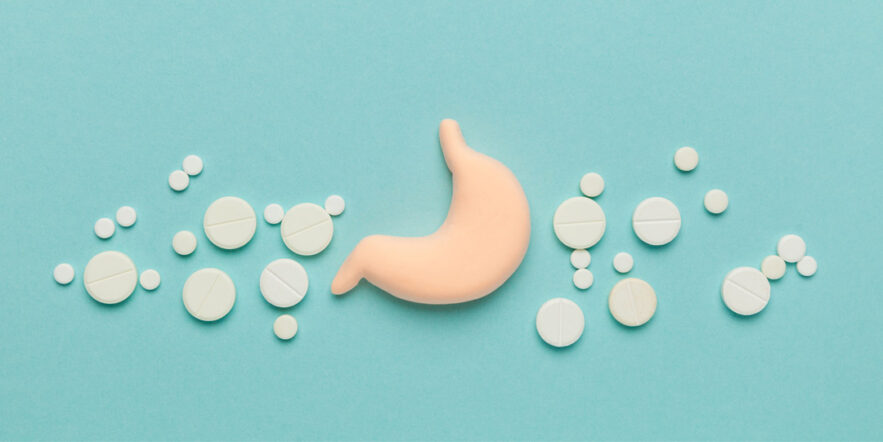For the 28 percent of Americans who experience gastroesophageal reflux disease (GERD), acid reflux occurring two or more times per week, proton pump inhibitors (PPIs) like Nexium, Prilosec and Prevacid, reduce the secretion of acid in the stomach and relieve their symptoms of heartburn, chest pain and a hoarse throat. Increasingly, however, studies and clinicians are warning about the serious side effects of long-term use of PPIs, which can range from colon infections to pneumonia, an irregular heartbeat to muscle spasms, bone loss to seizures and kidney disease. Some patients also find that they quickly become dependent on these medications, using them for years rather than for the four- to eight-week period usually recommended for GERD.
Browse This Article
GERD Symptoms and Treatment Options
Commonly called acid reflux, GERD is a chronic condition in which stomach acid or bile backs up — or refluxes — from the stomach into the esophagus. This happens because the lower esophageal sphincter (LES), a muscle that acts as a valve between the stomach and esophagus by opening temporarily to allow food and liquid to flow into the stomach, weakens over time or relaxes abnormally.
Symptoms include heartburn, a bitter taste in the mouth, chest pain, a dry, persistent cough, hoarseness, and a sensation of a lump in the throat. If untreated, GERD can damage the lining of the esophagus and lead to complications such as bleeding, ulcers, respiratory problems, scarring that causes swallowing difficulties, and in some cases, Barrett’s esophagus, a precancerous condition, which in turn can lead to cancer of the esophagus.
When it comes to treating patients diagnosed with GERD, physicians often turn to PPIs, which work by reducing the secretion of acid in the stomach. PPIs can relieve GERD symptoms, allowing the lining of the esophagus to heal, and proponents of the drugs note that they generally have a record of safety and effectiveness. They are available in both prescription and over-the-counter (OTC) forms. In addition to being used to treat GERD, they are prescribed for other disorders, including ulcers and inflammation of the esophagus.
Higher Doses and Prolonged Use Bring Problems
Robert Kuttner learned how easy it was to become dependent on a daily PPIs the hard way. After suffering frequent bouts of heartburn, he changed his diet and began taking Prilosec. But his symptoms worsened, so he followed his doctor’s advice and took increasingly higher doses of the drug for longer and longer periods. This cycle continued for seven years until he stopped taking Prilosec. He felt better within just a few weeks.
“As I learned, this stuff can create a dependency,” says Kuttner, co-editor of The American Prospect magazine. “It creates a rebound effect, and then you need more and more of it.”
In 2017 more than 102 million prescriptions were written for Prilosec (omeprazole), Nexium (esomeprazole), Prevacid (lansoprazole), Protonix (pantoprazole) and other brands of PPIs. Over-the-counter PPIs, also big sellers, include Nexium 24HR, Prevacid 24HR, Prilosec OTC and Zegerid OTC. But widespread use of PPIs doesn’t mean they are risk-free. Kuttner’s experience underscores what more and more medical studies indicate and what clinicians are warning: PPIs can lead to worrisome health problems, especially if taken for a year or longer.
Andrew Chan, MD, vice chair of gastroenterology at Massachusetts General Hospital, says that in general, most of the harmful side effects of PPIs are linked to higher doses and prolonged use of the drugs.
“You really want to encourage patients to take the lowest effective dose that manages symptoms effectively, for the shortest possible duration,” says Dr. Chan, professor at Harvard Medical School and a co-author of one of the studies that found a connection between regular PPI use and bone fracture.
This research, published in the BMJ, involved 79,899 women who answered questionnaires about PPI use over an eight-year period. Postmenopausal women who took PPIs for at least two years had a 35% higher risk of hip fracture compared with postmenopausal women who did not use the drugs, according to the study. Participants who were current or former smokers had an even greater risk: They were 50% more likely to sustain a hip fracture.
One theory behind PPIs’ negative effect on bone strength centers on the notion that because the drugs lower stomach acid, they may hamper the body’s absorption of calcium — a mineral vital to bone health.
More recent research has pointed to an association between PPIs and kidney problems. In a post-market analysis of more than 10 million adverse drug events reported to the FDA from January 2004 to March 2018, researchers found that people who took PPIs were at significantly greater risk for kidney disease compared to those who took H2 blockers, another type of heartburn drug that reduces stomach acid. The PPIs that appeared to have the strongest association with kidney risks were Prevacid (lansoprazole), Prilosec (omeprazole) and Nexium (esomeprazole). Notably, the researchers only took into consideration patients who were not taking any other medications.
A 2020 study in the journal Neural Regeneration Research that also looked at post-market adverse events found an association between PPI use and nervous system disorders. The researchers reviewed more than 50,000 adverse event reports from people taking PPIs or H2 blockers and determined that PPI users were at greater risk for neurological problems including hearing and visual impairment, migraines, seizures, neuropathy and dementia.
A 2016 study in JAMA suggested that long-term PPI use maybe associated with mild cognitive impairment. Some studies since then dispute the idea, but George Grossberg, MD, a geriatric psychiatrist at the St. Louis University School of Medicine says, “given that there are many safe alternatives to the PPIs for GERD, other options are more attractive, especially for older adults at risk for cognitive impairment.”
Research suggests that the reduction in gastric acid due to PPI use may also facilitate COVID-19 infection. An August 2020 study in the American Journal of Gastroenterology found an increased risk of COVID-19 in people who take PPIs for gastrointestinal (GI) symptoms. The researchers surveyed more than 53,000 people with a history of GI symptoms and found that those who took PPIs twice daily were nearly four times more likely to report a positive COVID-19 test than those who didn’t take PPIs. “Coronaviruses are easily destroyed at a gastric pH of less than three, but survive in a more neutral pH, including the range created by drugs like omeprazole (Prilosec) and esomeprazole (Nexium),” Brennan M.R. Spiegel, MD, of Cedar-Sinai Medical Center and a co-author of the study, said in a statement.
Other research, including a Danish study in the journal Gastroenterology has also shown that PPI use may lead to “rebound acid hypersecretion” — the rebound effect that Kuttner describes. According to the study, eight weeks of PPI therapy led to acid-related symptoms after the study volunteers stopped taking the drugs. According to a review of six studies on strategies for safely discontinuing PPIs, tapering seems to be the most effective way to reduce or discontinue treatment.
Researchers call for more studies to confirm these and other serious side effects and to clarify the possible mechanisms involved in their occurrence.
FDA Issues Safety Warnings
The FDA has issued several safety warnings about the use of prescription-strength PPIs and lower-dose OTC forms of the medicine. According to the federal agency, PPIs may lead to low levels of magnesium in the blood (hypomagnesemia), especially if taken for more than one year. Hypomagnesemia can cause muscle spasms, irregular heartbeat and seizures. The drugs may also be linked to greater risk of Clostridium difficile-associated severe diarrhea, according to a 2012 FDA warning.
In a study in the World Journal of Gastroenterology researchers examined 56 studies on the association between PPIs and Clostridium difficile (C. diff) and found that people who used PPIs had nearly double the risk of C. diff infection compared to those who didn’t use PPIs. The researchers theorized that since gastric acid acts as a barrier to ingested bacteria and bacterial overgrowth, and PPIs reduce gastric acid, C. diff spores are free to convert to an infectious form. Some research also found that the problems were reversible with cessation of PPI use.
“Evidence has been mounting for years that long-term use of proton pump inhibitors poses increased risks for a variety of associated complications, but we have never really understood why,” says John DiBaise, M.D., a Mayo Clinic gastroenterologist and senior author of one of the review studies on C. diff.. “What this research does for the first time is demonstrate a plausible explanation for these associated conditions.”
The FDA also put out a safety warning that use of prescription PPIs for long periods of time has been associated with pneumonia, fractures of the hip, wrist and spine, and iron and vitamin B12 deficiencies.
While no measures have been consistently shown to prevent or minimize side effects, Dr. Chan says, certain steps may help. For example, PPI users can lower their risk of hip fracture by boosting their calcium intake and staying physically active.
Drug Interactions
PPI labels now carry warnings about possible interactions with certain drugs, including methotrexate, which is used to treat psoriasis, rheumatoid arthritis and some cancers. Nexium and Prilosec labels include an interaction warning about clopidogrel, which prevents blood clots.
PPIs may interact with the above drugs and other medicines by affecting how they are metabolized by the body or interfering with their absorption. As a result, the effectiveness of the other medication, such as the blood thinner clopidogrel, may be decreased. Or the risk of side effects, such as tachycardia when they’re taken with the antidepressant citalopram, may be increased.
Before you head to the pharmacy to fill your PPI prescription, tell your doctor about all the medicines and supplements you take. Other drugs and supplements that may interact with PPIs include:
- other blood thinners, such as warfarin
- diazepam (anxiety medication)
- digoxin (heart medicine)
- ketoconazole and other antifungal drugs
- phenytoin (a seizure drug)
- tacrolimus (immune system medicine)
- antiretroviral drugs such as atazanavir (for HIV infection)
- medicines and supplements containing iron
- St. John’s wort
Each PPI can cause side effects that fall into the “less serious” category, according to the Physicians’ Desk Reference and other medical sources. These include headache, nausea, gas, mild diarrhea and insomnia. Be sure to tell your doctor if you experience these, or any other, side effects.
What Are the Options?
Before relying on PPIs to prevent or lessen GERD symptoms, Dr. Chan says, people should make lifestyle changes, such as losing weight, avoiding foods that trigger or aggravate symptoms, refrain from smoking and minimize alcohol intake. Other lifestyle changes include these simple strategies:
- Don’t lie down for two to three hours after eating.
- Eat smaller and more frequent meals instead of a few large meals.
- For pain relief, avoid aspirin, Advil or Motrin (ibuprofen), Aleve or Naprosyn (naproxen). Take Tylenol (acetaminophen) instead.
- Drink plenty of water when you take any medicine. If you are prescribed a new medicine, ask your doctor if it will worsen your acid reflux symptoms.
- Use an extra pillow or two to elevate your head in bed, or raise the head of your bed by about six inches by placing wood or cement blocks under the legs at the head of the bed. Plastic risers are also available online and are typically advertised as a way to increase storage space under your bed. Be sure to look for sturdy risers that can support your weight and your bed’s weight.
- Avoid tight waistbands, belts and other clothing that fits snugly around your waist.
“Sometimes there isn’t any other option than to take these medications,” says Dr. Chan, noting that the best candidates for PPI therapy are patients who have adjusted their lifestyles but continue to experience GERD symptoms on a regular basis.
Physicians typically recommend avoiding a long list of foods and beverages thought to cause or worsen GERD symptoms by boosting stomach acid production, irritating the esophageal lining or relaxing the LES. They include fried, fatty or spicy foods, tomatoes, tomato sauce, citrus fruits and juices, garlic, onion, chocolate, mint, coffee, carbonated drinks and alcohol. But not everything on that “foods to avoid” list is a problem for every patient, says Dr. Chan, who recommends using the guidelines as a starting point.
“I generally ask patients to keep a food diary and record their symptoms to see if there are any particular foods that are associated with their symptoms, then work to eliminate those foods and see if that makes a difference.”
Coffee, butter and cream are the main culprits for him, Kuttner says. “As long as I watch my diet and take a low dose of Pepcid (famotidine, an H2 blocker), I’m fine.”
Some GERD sufferers also find relief by using certain herbs. Chewing licorice root extract tablets before meals may help ease inflammation on the surface of the gastrointestinal (GI) tract . DGL — deglycyrrhizinated licorice — products are the safest licorice to use because they do not contain glycyrrhizin, a compound that in high amounts can cause serious side effects, including high blood pressure, headaches, fatigue and reduced potassium levels.
DGL, which usually is taken 20 minutes to an hour before a meal, is a demulcent — it helps protect the esophagus from acid reflux by coating the esophageal lining.
To be safe, consult your doctor before trying DGL, especially if you have high blood pressure or take diuretics, corticosteroids or other drugs that decrease the body’s potassium levels. If taken with those medicines, licorice can cause dangerously low potassium levels.
If you have been diagnosed with GERD, consider trying behavior and lifestyle changes first to see if you feel better. If not, talk to your doctor about your options. You may discover that you can keep your symptoms in check by taking an OTC antacid as needed — a safer alternative to a PPI drug, whose risks may outweigh the benefits.







